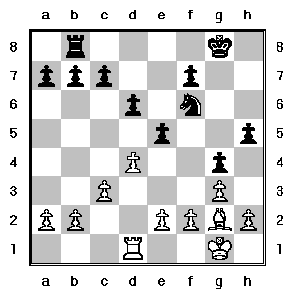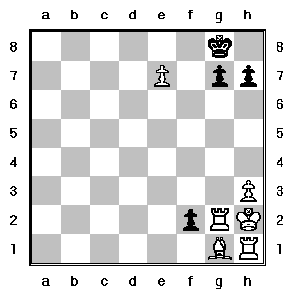Rule-23 The position shows nine Pawns standing on the squares where they stood at the start of the game: a2, b2 e2, f2, h2, a7, b7, c7, f7; they have not moved yet; the other seven Pawns have advanced during the progress of the game. The Pawn d4 has two possible moves: to advance to d5 or to capture e5. The Pawn c3 has only one possible move: to advance to c4.
About four centuries ago, the rule was introduced that Pawns in their initial position and which are not blocked may advance one or two steps according to the plan of the player. This rule made the game more lively, and therefore the Chess world accepted it over time. For instance, Pawn a2 may advance to a3 or to a4 in one move.
With this rule a difficulty arose. Its object was to accelerate the pace of the Chess events and to add to their variety, but sometimes it betrayed the obvious rights of the opponent.
To illustrate this point, look at the two Pawns f2 and g4. The Pawn g4 stands on guard over f3. If f2 advances to f3, g4 can capture it; thus it had been for many centuries; after the introduction of the new rule, Pawn f2 could evade Pawn g4 by advancing at once to f4 and could then molest Black unpunished. Naturally, the Pawn g4 on guard felt deceived, when the hostile Pawn crept through the advance posts.
Rule -24 There were scenes of hot dispute. It could not be the meaning of the innovation to make the advancing Pawn immune. And finally justice was victorious: the Pawn standing on guard was acceded the right of capture, just as if the Pawn trying to slip through had advanced one step only; but the Pawn on guard cannot defer this movement but must execute it without loss of time as an immediate reply to the attempted advance. If, for instance, in the above position White moves f2-f4 Black may answer g4 captures f3, thus executing his original intention of capturing the Pawn on f3. This species of capture is named "capture in passing" or, with the French expression capture "en passant". If the Pawn, after f2-f4, is not immediately captured by g4 "in passing," it stays unmolested on f4 and has thereafter to contend only with the hostile Pawns of the f and e files.
The Pawns only advancing ahead arrive, in advancing row by row finally to the eighth row where according to the rule they would come to a barrier and would be immobile. Should this signify their death? Should they now become useless after having done their duty and fought their way through the ranks of the enemy? That would not be in keeping with justice. Since in a struggle it is honorable to draw upon oneself the fire of the enemy and to do him harm, the Pawn advancing to the last row is rewarded by becoming an "officer" in its army; it is changed for a Queen, Rook, Bishop or Knight, according to the will of the player; it is promoted to a higher rank since officers have much more mobility and value than Pawns.
If it is White's turn to move here, he may advance Pawn e7 to e8, change it for a Queen and call Mate. If it is Black's turn to move, he can advance f2 to f1, demand a Knight and Checkmate White.
Pawn Promotion
Rule - 25 Pawns are the only piece in chess that may promote.
Promotion occurs when the Pawn reaches the opposite side of the board (1st rank for black, 8th rank for white).
In the same turn, the Pawn is removed from the board and is replaced with an extra piece of the promoting player’s choice [see figure 10.1 & 10.2 below], (Queen, Rook, Bishop, or Knight) even if these pieces are already on the board.
This concludes the player’s turn.
Rule -26.Castling is a special move to protect your king and activate your rook. It's the only time in chess you can move two pieces in one move. The king moves two squares to the right or left and the rook moves directly to the other side of the king. You can only castle if neither the rook or king have moved and there are no pieces in the way. You can also not castle when in check, into check or through check.
..



Give the real image of rule number 26
ReplyDelete